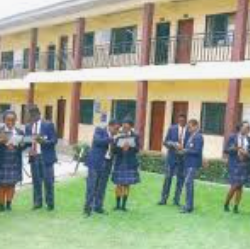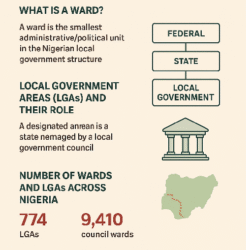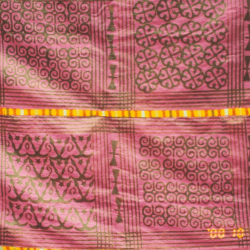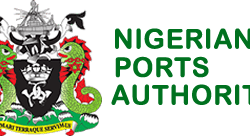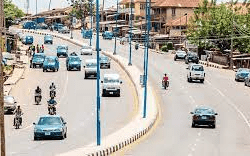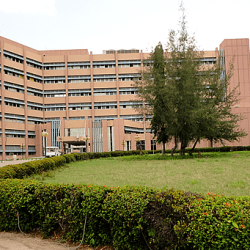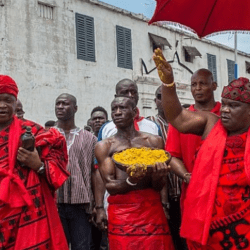The Asante people have developed their unique art of adinkra printing. They use two traditional printing methods; the block-stamp technique, which involves the use of wooden or metal stamps and the screen-printing.

The Adinkra cloth was originally printed from hand carverd stamps from calabash or gourd (apakyiwa). The dye or ink (adinkra aduru) for printing is derived from the bark of the Badie and the roots of the kuntunkuni trees.
The bark and roots are soaked in water for days to soften. They are then pounded to increase the softening process. The 4 Badie bark is boiled with iron scraps. When the colour (deep brown) emerges from the pulp it is sieved and engraved onto a piece of calabash or pot.

The kuntunkuni roots are also boiled into a dark solution to dye the cloth black. The Cloth is dipped and soaked in the solution. It has to be dried several times before it turns completely black.

The cloth is normally dyed in either red or black. For the red Adinkra cloth, a chemical called Sudi is used instead of the kuntunkuni root.
The Stamps
The various stamps carved from the calabash are tinted with dye and pressed in sequence onto plain cotton cloth, pegged on the ground. Today raised platforms with sack covering act as the printing table. 5 In recent times imported cloth is used as the background of the cloth.
Sometimes the various symbols are used on one fabric and this also has its significance. The designing is done according to the message the wearer or owner of the cloth intends to convey to the participants of the event. The quality of the cloth also shows the status of the one wearing it.
The original Adinkra cloth is not meant to be washed since it faded easily as a result of the natural ink used without any chemical additives. Today, other types of cloth are used with the same adinkra motives but stamped in indelible colours using the batik method. Ntonso, a town in the Ashanti Region is noted for
Other uses of the Adinkra symbols
Adinkra symbols can be described as small, symbolic pictures or motives used to decorate colourful patterned cloth by fashion designers in Ghana.
Designers in modern times use Adinkra symbols in creating and decorating other accessories than cloth.
Other artisans/crafts men such as sculptors, carpenters, and architects also use the symbols to design their products.
Some corporate institutions in Ghana now use the Adinkra symbols as their institutional Symbol or Logo.
Types
The 3 most important funerary Adinkra are the dark – brown (kuntunkuni) the brick – red (kobene) and the black (brisi). There are however, other forms of which cannot be properly called mourning cloth. Their bright and light backgrounds classify them as 3 Kwasiada Adinkra or Sunday Adinkra meaning fancy cloths which cannot be suitable for funerary contents but appropriate for most festive occasions or even daily wear.
Symbolism, significance
The Adinkra symbols express various themes that relate to the history, beliefs and philosophy of the Asante. They mostly have rich proverbial meaning since proverbs play an important role in the Asante culture. The use of Proverbs is considered as a mark of wisdom.
Other Adinkra symbols depict historical events, human behaviour and attitudes, animal behaviour, plant life forms and shapes of objects. 2 In fact, the Adinkra symbols continue to change as new influences impact on Ghanaian culture as some of the symbols now record specific technological developments.
The Adinkra cloth is stamped or printed with Adinkra symbols. It is one of the few examples of traditional cloths in Africa.
The Adinkra cloth was hitherto the preserve of the royalty and spiritual leaders of the Asantes. They wore it during very important sacred ceremonies.
Today the Adinkra cloth is used for a wide range of social activities such as festivals, marriage, and naming ceremonies among others.
